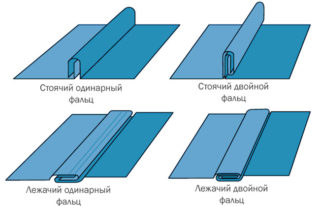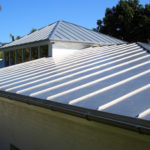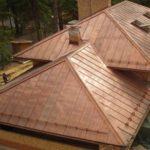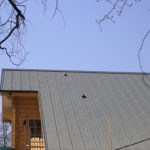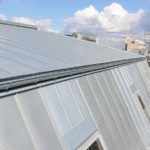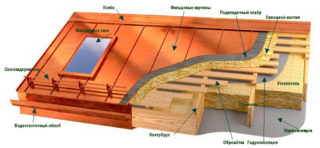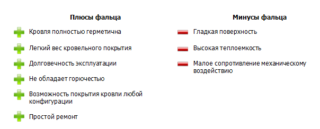The service life of the building, the comfort of living in it and even the order in the territory adjacent to the structure depend on the quality of the design and the correct choice of material for arranging the roof. Seam roofing is often a priority for property owners. This coating option combines a lot of advantages, one of which is the ability to do it yourself. To achieve the desired result, you should study the features of this design, draw up a competent project and, in accordance with the instructions, carry out the installation.
What is a seam roof
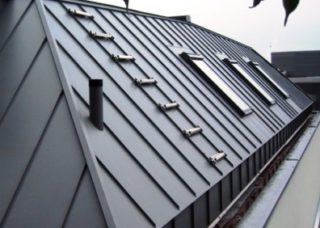
A seam roof is a prefabricated surface consisting of sheet metal strips interconnected in a lock. Docking is carried out by bending the edges of the sheets with their subsequent crossing and squeezing. Several decades ago, this procedure was carried out using hand instruments. The development of technology contributed to the invention of the machine, with the help of which the installation of seam roofing began to be carried out in a semi-automatic mode. This allows you to obtain a seam with perfect accuracy and the same size along the entire length.
A distinctive feature of a seam roof is the absence of welding, drilling holes and the continuity of the seams. This completely eliminates the possibility of leaks and the development of rust. The reliability of the joints is achieved by the functionality of modern seaming machines. A folded roof has been developed, the assembly of which can be carried out without special devices using locks. Property owners do not have to worry about the aesthetic component. A wide range of materials for roof seam is able to satisfy the most sophisticated taste.
The technology of fastening metal sheets is so perfect and reliable that it begins to surpass in popularity such types of roofs as slate, profiled sheet and tiles.
Basic rules of the device
The seam roofing device in most cases does not differ from the standard design, which is taken as the basis for the construction of residential, commercial and office buildings. A rafter system, lathing, insulation and waterproofing are being made. An exception is the construction of cold rooms where there are no insulating layers. The fundamental difference from slab structures is the obligatory arrangement of a dense and even base for covering. This condition is justified by the fact that when rolling, the roofing material is subjected to strong vertical loads, and in the absence of a solid base, it will not be possible to achieve a tight connection. If there is no base under the steel, it will sag over time, which will disrupt the geometry of the roof and spoil its appearance.
When manufacturing a seam roof, you should adhere to the following rules:
- Use only stainless steel. This applies to cladding and fasteners.
- When joining sheets, sealant must be added to the locks. The layer of wet snow on the roof can be higher than the fold, and this is fraught with the penetration of water into the attic space.
- The connection need not be only longitudinal. For transverse joining, other types of rolling are used, which differ in their insignificant size.
- The installation of the coating is carried out on special clamps - profiles screwed to the supporting roof system.This prevents the cover from slipping and being torn off by strong gusts of wind.
The manufacture of the roof must be carried out in the direction from bottom to top with strict observance of the vertical position of the clamps.
Varieties of standing seam roofing
Types of folds that are used in the installation of sheet metal roofs:
- Single. A single bending of adjacent canvases about a vertically located fastening element is carried out. It is the easiest to manufacture, but unreliable option. When finishing chimneys, windows and other square walk-through objects, a transverse knot is made, in which the butt element is bent close to the metal. Such a single joint is called recumbent.
- Double. Here, a double bending of the second sheet about the kleimer is performed. At the same time, a more durable, reliable and tight connection of the fragments is achieved. A type of seam is its flat version, which, like a single one, bends to the surface.
- Self-latching. It is a set of ready-made sheets, the edges of which are given a special shape at the factory. Docking is created by aligning the fragments and pressing on their edges. As a result, the locking system is triggered and the surface acquires integrity. This is a good option for craftsmen who do not plan to buy a seamer and waste energy when using it.
If large sheets are used, a flexible connection method should be chosen to ensure thermal expansion of the metal.
Metal for making
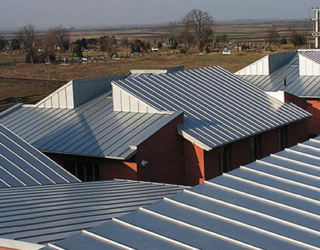
In specialized retail outlets, a wide selection of rolled and forged materials of domestic and foreign production is presented.
There are the following options:
- The best choice is stainless steel, which has an almost unlimited lifespan. If you buy sheets based on black iron, you should stop at galvanizing or several layers of polymer spraying. It is impossible to galvanize metal on your own with high quality, so you should take factory-made products.
- Copper. This is the most practical material with a long history of use. It is characterized by flexibility, ease of installation and lack of inclination. Metal looks great at all stages of operation. At first, it shines brightly and beautifully, then gradually darkens, and then becomes covered with a noble patina. The minus of copper is its high cost and softness. The surface can be damaged by hail or a hard object thrown onto the roof.
- Aluminum. Lightweight and durable plates are resistant to corrosion, pressure and impact. In addition, the surface of the metal looks great, creating silvery reflections that are pleasing to the eye. However, it has a significant drawback - a high coefficient of thermal expansion. To reduce its impact, you will need to think well and spend money.
- Zinc titanium. The alloy of two metals is characterized by high performance characteristics. Both are very robust, corrosion resistant and have a good surface finish. The service life is at least 100 years. The zinc-titanium alloy does not require any maintenance.
- Aluzinc. It is a unique material, which is a sheet of iron coated with an alloy of aluminum and zinc. Its peculiarity lies in its resistance to corrosion and the ability to tighten scratches.
- Pural. This type of coating is particularly resistant to all types of corrosive liquids. Pural maintains its performance in contact with acids, salty sea winds and ultraviolet radiation.
When choosing a coating, it is recommended to give priority to materials that are distinguished by maximum strength and durability.Repair of damaged parts is, in most cases, impossible; dismantling of the entire roof is required.
Installation tools
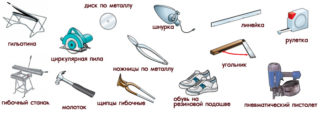
Since the work will be carried out at a height, you first need to think over the issues of ensuring your own safety. You must have a stable ladder and reliable belay. Gloves and safety glasses are required to avoid harm to health.
You will need the following tools:
- tape measure, level, marker;
- a hammer;
- mallet;
- ticks;
- Bulgarian;
- screwdriver;
- scissors for metal;
- thermal gun with a stock of silicone rods.
Around the building, install a fence or stretch warning tape with warning signs to eliminate the possibility of injury from falling from the top of tools and materials.
Installing a seam roof with your own hands
Further work is carried out in the following sequence:
- Surface preparation. The supporting structures should be treated with an antiseptic and fire retardant. To keep the steel flat, you need to remove the protruding fragments and repair the depressions. Finally, apply the markings.
- Give the blanks the desired shape. If rolled steel is purchased, trim it to length. Prepare additional elements for connecting the roof with pipes and skylights.
- Lift the metal onto the roof and place the first piece of steel in the middle of the supporting structure. Fasten it to the clamp, screw it to the base, and then attach the second sheet. Then apply sealant to the seam and roll up the joint with a machine.
- After installing large sheets, make molded inserts to connect the roof to the roof fragments.
In conclusion, the cornice bar is attached and the quality of the work performed is checked.
Advantages and disadvantages
Advantages of seam roofing:
- long service life due to the use of modern materials;
- the covering can be attached to any type of lathing;
- complete tightness, subject to the installation rules;
- ease of installation with special fixtures;
- reliability of connecting seams;
- applicability to roofs of any configuration and complexity;
- lack of holes.
The disadvantages of such a coating include the rather strong noise that it makes during rain. You can get rid of it by installing a solid base with a snug fit of the sheets. The thermal expansion of the metal is compensated by movable clamps.
The minimalism of the aesthetic side of the structure can be easily eliminated by applying paint, film, mosaics and paintings to it.

